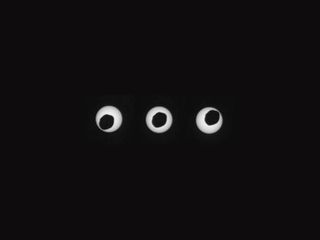
Do other planets have solar eclipses?

As Earthlings, we have the privilege of ooohing and aaahing at total solar eclipses, those dazzling celestial events in which the moon blocks the sun's light from hitting our planet. But is Earth the only world in our solar system that experiences this spectacular phenomenon?
The answer is no. Total solar eclipses can happen on other planets too, as long as they have moons that are big enough to cover the sun's disk from the planet's perspective and orbit the planet on the same plane as the sun, astronomers told Live Science.
A total solar eclipse occurs when a planet, its moon and the sun are aligned along the same plane, and a substantially sized moon passes between the planet and its sun, totally blocking the sun's light from reaching the planet.
"To get a solar eclipse, the first thing you need is a moon," said Christa Van Laerhoven, a postdoctoral fellow of astronomy at the University of British Columbia in Canada. "This immediately rules out solar eclipses on Mercury or Venus" — two planets without moons, she said. [What Would Earth Be Like with Two Suns?]
Mars has two moons — Phobos and Deimos — but both are too small to create total solar eclipses that would be visible from the Red Planet. Rather, these moons can make partial eclipses for any potential life-form (or Mars rover) watching from the ground, Van Laerhoven said.
"The view from those little moons is more interesting: They see Mars eclipsing the sun very frequently, and during some seasons, it happens every day," astronomer Matija Cuk wrote on the Cornell University blog "Ask an Astronomer."
The gas giants — Jupiter, Saturn, Uranus and Neptune — can all have total solar eclipses, as they have large moons and the sun appears small to them, Cuk said. But because these planets are made of gas, it would be impossible to stand on them and see such solar eclipses, he said.
Sign up for the Live Science daily newsletter now
Get the world’s most fascinating discoveries delivered straight to your inbox.
However, if you had a special spaceship that could hover near the swirling gas giants, you could very well glimpse a solar eclipse. Jupiter has up to 67 moons, including Ganymede, the largest moon in the solar system. Because Jupiter's moons orbit on the same plane as the sun, the planet can have solar eclipses, Cuk and Van Laerhoven said.
In fact, if you could land on one of Jupiter's moons, you could see its other moons eclipse the sun, the astronomers said.
But what about dwarf planets, such as Pluto? "Charon [Pluto's largest moon] is large enough and close enough to Pluto to produce total solar eclipses for Pluto," Van Laerhoven said. But because the same side of Pluto and Charon always face each other, "only one side of both Pluto and Charon will ever experience eclipses," Cuk wrote.
On Earth, the moon is almost perfectly suited to making eclipses. The moon is the right size — that is, it appears to be the same size or larger than the apparent size of the sun, as seen from Earth. "This means that when the moon passes in front of the sun, the photosphere [the sun's luminous outer shell] gets covered, but the corona [the sun's upper atmosphere] remains visible," Van Laerhoven said. [Why Total Solar Eclipses Are Total Coincidences]
She noted that Earth's moon is slowly moving farther away from our planet, so in the distant future, the moon's apparent size will be too small to entirely cover the sun, at least from Earth's perspective. This means that one day, the moon won't be able to cause total solar eclipses but only annular eclipses, in which a "ring" of the sun's disk is still visible, Van Laerhoven said. Experts speculate that Earth will experience its last total solar eclipse about 600 million years from now.
For now, however, the moon is in prime location to cause a total solar eclipse.
"The reason we don't get solar eclipses every month is because the moon's orbital plane is slightly misaligned from Earth's orbital plane around the sun," Van Laerhoven said. "If they are misaligned, that decreases your chances of having a solar eclipse. You only get it when things happen to be lined up."
REMEMBER: Looking directly at the sun, even when it is partially covered by the moon, can cause serious eye damage or blindness. NEVER look at a partial solar eclipse without proper eye protection. Our sister site Space.com has a complete guide for how to view an eclipse safely.
Original article on Live Science.

Laura is the archaeology and Life's Little Mysteries editor at Live Science. She also reports on general science, including paleontology. Her work has appeared in The New York Times, Scholastic, Popular Science and Spectrum, a site on autism research. She has won multiple awards from the Society of Professional Journalists and the Washington Newspaper Publishers Association for her reporting at a weekly newspaper near Seattle. Laura holds a bachelor's degree in English literature and psychology from Washington University in St. Louis and a master's degree in science writing from NYU.
Most Popular


